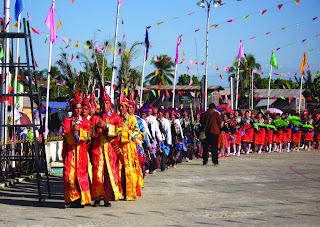Yet it is precisely these things that seem to have been the source of inspiration for numerous tribes in the creation of costumes and folktales! And because we just happen to
For assistance with this post, as well as for allowing us to use these photos, we would like to thank Karelin Loh (Single, fabulous and *ahem ahem* available).
Far, far away, in the snow capped mountains of Myanmar, is the state of Kachin. The people of Kachin can be further broken down into several different ethnicities. Unsurprisingly, this is reflected in both their dressing, as well as their speech. Surprisingly, the Kachin are present not only in Myanmar, but in parts of China and India as well. Yet further proof of how colonial powers did not take into consideration how communities were spread when they decided to just go along and erect artificial boundaries to create countries.
Binding these unique communities, is their celebration of the Manau festival, during which, the Manau dance is...well...danced around the colourfully decorated poles you see below. The designs on the beams are inspired by nature, as is often the case with rural tribes- animals, plants, the Sun, the Moon, and even Earth!
On one of the horizontal cross beams(there are 12 beams in total), though not visible here, a hornbill head is carved at one end, and on the other, the tail of the hornbill, since this bird plays a very central role in the origins of the Manau festival. In fact, the hornbil was often interpreted as being symbolic of the chief, who maintained unity and order.
 |
| Manau Festival...poles?! |
There are several different stories that tell the origins of this festival. One of the many versions:
Once upon a time, the Sun God summoned to his court a community of birds, for the sole purpose of entertaining him with their dance. This group, led by a Hornbill proceeded to dance for him. Later, these birds then taught the Kachin the same dance, and it has been danced by the Kachin ever since, in honour of a spirit.The details are a little sketchy, mainly because information on tribal stories is, unfortunately, difficult to come by. So much knowledge not yet formally recorded down, whether the subject matter is culture or nature. Will we lose everything before we even begin to understand our world?
 |
| Leaders of Manau festival, followed by the various clans |
 |
| Headdress of the leaders constructed of hornbill and peacock feathers |
References
Sadan, M. (2002). The Kachin manau and manau shadung: the development of an ethno-cultural symbol in Burma. In T. R. Alexandra Green, Burma: Art and Archaeology (pp. 119-132). Chicago: Art Media Resources.

No comments:
Post a Comment